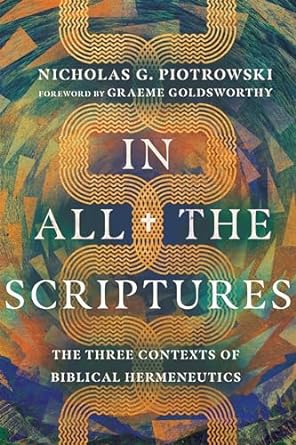A Book Review from Books At a Glance
by Jacob Hercamp
In In All the Scriptures, Nicholas G. Piotrowski offers what may be called a hermeneutics textbook designed for undergraduate students. Piotrowski aims to help these students build a “theoretical-philosophical foundation reading the Bible” (Pg. 16). This book exceeds this goal, and Piotrowski shows how important it is to read the Bible from a Christological perspective.
Piotrowski lays out his modus operandi in the introduction, and in chapters 1 and 2, he argues that the Bible deserves to be read in Christological terms. In other words, the reader of the Bible needs to have his worldview shaped by the continual reading of the Bible (Pg. 48). In chapters 3–6 Piotrowski makes his case for his three-fold contextual model. Chapter 3 investigates the importance of the literary context, arguing for a close reading of the text considering the larger context of the book in which the pericope lives. Chapter 4 deals with reading Scripture in light of its historical context. Doing so forces the reader of Scripture to deal with the text’s original message and hearers and throw off “our own cultural assumptions” (Pg. 101–103).
Piotrowski argues in chapters 5–6 that the OT should be viewed as “Christotelic” since it all leads to Christ. The NT should be considered Christocentric. When taken together, the entire Bible should be viewed as Christological (Pg. 158)). This may be the most intriguing part of the book. When speaking about how the OT moves to the “gospel” Piotrowski describes five different approaches found. (1) OT quotations, echoes, and allusions in the NT; (2) Prophecy; (3) Typology; (4) Major recurring themes; (5) “Whole book contexts” (Pg. 189–195).
Since typology can be thought of as a “naughty word” for some in the scholarly community, Piotrowski insists on being led by the text when finding types and not one’s own imagination. He is against the use of allegory because of how it can move away from the literary and historical context of the text in question (Pg. 167).
In the final chapters, Piotrowski concludes his argument. In chapter 7, he offers general when working with specific genres of Scripture. In chapter 8, Piotrowski speaks to the question of application. This discussion is a welcome addition to the volume.
The merits of this book are vast. Piotrowski exceeds his goal, offering a book that deals with a complex topic in a fresh and insightful way. I believe undergraduate students, seminary students, and pastors will all benefit from having this book close by as they exegete and craft Christological applications from the Scriptures.
Jacob Hercamp
Midwestern Baptist Theological Seminary
